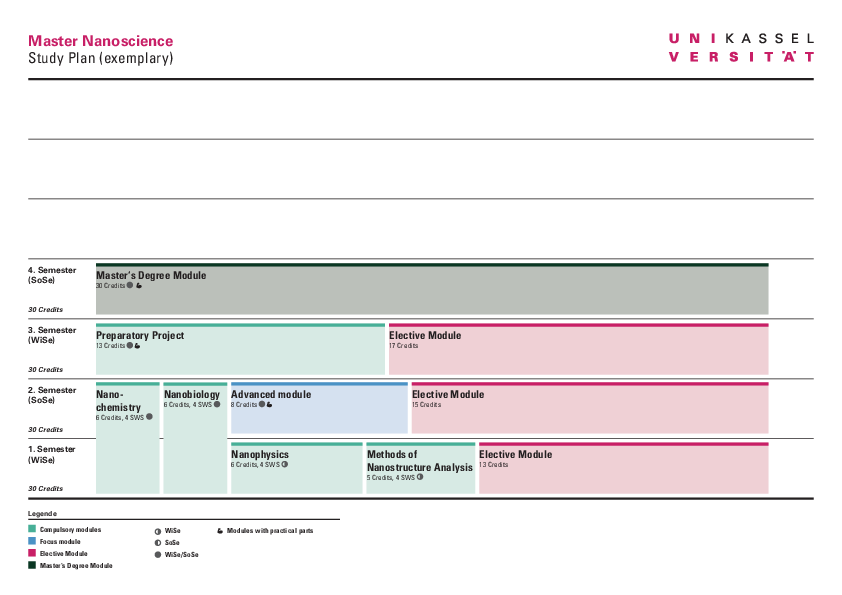Program structure
This page contains automatically translated content.
The modules of the consecutive study programme Nanoscience are divided into compulsory modules, focus modules an delective modules. In the first year, you will have to attend courses called Nanochemistry, Nanophysics or Nanobiology, from which you may choose two (or all three, if you like). All courses consist of two parts, one in the winter semester and one in the summer semester. In chemistry and biology you can choose any order. In physics, it is recommended that you keep the order, so if you start in the summer, you should take Nanophysics in your second and third semester.
In addition, there are three compulsory modules: a course in analytical methods in nanoscience given in the winter semester, a preparatory project just before the thesis, and the Master's degree module with the thesis.
For shaping your personal profile, you may select from a variety of modules according to your interests. Modules are offered from chemistry, physics, biology, and electrical engineering, all covering different aspects of nanostructure science. Many modules contain laboratory work, especially the more advanced internship courses offered by various research groups of the Center for Interdisciplinary Nanostructure Science and Technology (CINSaT). If you are interested in computer simulations, you will find special theoretical modules dedicated to this aspect of nanoscience.
In the thesis, you work on a special research topic in nanoscience, in which you can apply the interdisciplinary approach you experienced in the curriculum. The Master degree opens the door to a job in industry or government, or to PhD studies, if you want to pursue you academic career further.
In the first year, you will have to attend courses called Nanochemistry, Nanophysics or Nanobiology, from which you may choose two (or all three, if you like). All courses consist of two parts, one in the winter semester and one in the summer semester. In chemistry and biology you can choose any order. In physics, it is recommended that you keep the order, so if you start in the summer, you should take Nanophysics in your second and third semester.
In addition, there are three compulsory modules: a course in analytical methods in nanoscience given in the winter semester, a preparatory project just before the thesis, and the Master's degree module with the thesis.
For shaping your personal profile, you may select from a variety of modules according to your interests. Modules are offered from chemistry, physics, biology, and electrical engineering, all covering different aspects of nanostructure science. Many modules contain laboratory work, especially the more advanced internship courses offered by various research groups of the Center for Interdisciplinary Nanostructure Science and Technology (CINSaT). If you are interested in computer simulations, you will find special theoretical modules dedicated to this aspect of nanoscience.
In the thesis, you work on a special research topic in nanoscience, in which you can apply the interdisciplinary approach you experienced in the curriculum. The Master degree opens the door to a job in industry or government, or to PhD studies, if you want to pursue your academic career further.
